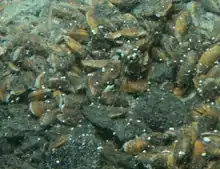Bathymodiolus
Bathymodiolus ist eine Gattung von „Tiefsee-Miesmuscheln“ aus der Familie der Miesmuscheln (Mytilidae); es ist die Typusgattung der Unterfamilie Bathymodiolinae. Die Arten dieser Gattung züchten in den Kiemen bakterielle chemoautotrophe Symbionten.
| Bathymodiolus | ||||||||||||
|---|---|---|---|---|---|---|---|---|---|---|---|---|

Abbildung einer Tiefsee-Miesmuschel (Bathymodiolus spec.) | ||||||||||||
| Systematik | ||||||||||||
| ||||||||||||
| Wissenschaftlicher Name | ||||||||||||
| Bathymodiolus | ||||||||||||
| Kenk & Wilson, 1985 |
Merkmale
Das längliche, gleichklappige Gehäuse ist glatt mit einem gebogenen oder gewinkelten Dorsalrand. Der Ventralrand ist bei kleineren Exemplaren annähernd gerade, bei größeren Exemplaren auch leicht konkav gebogen. Die Gehäuse werden recht groß; bis zu 30 cm lang. Die Schale ist fest, die Oberfläche weitgehend glatt mit einem glatten oder auch haarigen Periostracum. Der Wirbel sitzt nahe am gerundeten Vorderende. Das Schloss ist zahnlos. Der hintere Retraktormuskel teilt sich in zwei Bündel. Der Ausströmsipho ist kurz und ausstreckbar mit einem inneren Diaphragma.
Geographische Verbreitung und Lebensraum
Bathymodiolus-Arten kommen an (kalten) Methanquellen und hydrothermalen Quellen (Schwarzen Rauchern) in Wassertiefen zwischen 630 und 3500 Metern vor, wo sie ausgedehnte Muschelfelder um die Quellen herum bilden können. Die in besonderen Zellen (Bacteriocyten) im Kiemenepithel der Tiefsee-Miesmuscheln lebenden Schwefel- und/oder Methan-Bakterien[1] ernähren sich vom Methan bzw. Schwefelwasserstoff, das aus dem Meerwasser aufgenommen wird.
Taxonomie und Systematik
Das Taxon wurde 1985 durch Vida Carmen Kenk und Barry Wilson erstmals beschrieben; zur Typusart bestimmten sie die ebenfalls neue Art Bathymodiolus thermophilus[2] Derzeit (2015) sind folgende Arten akzeptiert[3]:
- Gattung Bathymodiolus Kenk & B. R. Wilson, 1985
- Bathymodiolus aduloides (Hashimoto & Okutani, 1994)
- Bathymodiolus antarcticus S. B. Johnson & Vrijenhoek, 2013
- Bathymodiolus anteumbonatus Cosel & Janssen, 2008
- Bathymodiolus azoricus Cosel & Comtet, 1999
- Bathymodiolus boomerang Cosel & Olu, 1998
- Bathymodiolus brevior Cosel, Métivier & Hashimoto, 1994
- Bathymodiolus brooksi Gustafson, Turner, Lutz & Vrijenhoek, 1998
- Bathymodiolus childressi (Gustafson, Lutz, Turner & Vrijenhoek, 1998)
- Bathymodiolus edisonensis Cosel & Janssen, 2008
- Bathymodiolus elongatus Cosel, Métivier & Hashimoto, 1994
- Bathymodiolus heckerae Turner, Gustafson, Lutz & Vrijenhoek, 1998
- †Bathymodiolus heretaunga Saether, Little, K. A. Campbell, B. A. Marshall, M. Collins & Alfaro, 2010 (Miozän, Neogen)
- Bathymodiolus hirtus Okutani, Fujikura & Sasaki, 2004
- †Bathymodiolus inouei Amano & Jenkins, 2011 (Oberes Oligozän)[4]
- Bathymodiolus japonicus Hashimoto & Okutani, 1994
- Bathymodiolus manusensis Hashimoto & Furuta, 2007
- Bathymodiolus marisindicus Hashimoto, 2001
- Bathymodiolus mauritanicus Cosel, 2002
- †Bathymodiolus palmarensis (Kiel, Campbell & Gaillard, 2010)
- Bathymodiolus platifrons Hashimoto & Okutani, 1994
- Bathymodiolus puteoserpentis (Cosel, Métivier & Hashimoto, 1994)
- †Bathymodiolus satsopensis Kiel & Amano, 2013 (Oberes Oligozän, Paläogen)[4]
- Bathymodiolus securiformis Okutani, Fujikura & Sasaki, 2004
- Bathymodiolus septemdierum Hashimoto & Okutani, 1994
- Bathymodiolus taiwanensis Cosel, 2008
- Bathymodiolus thermophilus (Kenk & Wilson, 1985)
Abbildungen
 Bathymodiolus thermophilus
Bathymodiolus thermophilus Bathymodiolus childressi
Bathymodiolus childressi Bathymodiolus brooksi
Bathymodiolus brooksi Lebensumgebung der Gattung Bathymodiolus in der Tiefsee
Lebensumgebung der Gattung Bathymodiolus in der Tiefsee
Literatur
- S. Peter Dance, Rudo von Cosel (Bearb. der deutschen Ausgabe): Das große Buch der Meeresmuscheln. 304 S., Verlag Eugen Ulmer, Stuttgart, 1977 ISBN 3-8001-7000-0 (S. 227)
- Rudolf Kilias: Lexikon Marine Muscheln und Schnecken. 2. Aufl., Verlag Eugen Ulmer, Stuttgart 1997 ISBN 3-8001-7332-8 (S. 206)
- Kristian P. Saether, Crispin T. S. Little, Kathleen A. Campbell, Bruce A. Marshall, Mike Collins, Andrea C. Alfaro: New fossil mussels (Bivalvia: Mytilidae) from Miocene hydrocarbon seep deposits, North Island, New Zealand, with general remarks on vent and seep mussels . Zootaxa, 2577: 1–45, 2010 PDF
- Jun-Ichi Miyazaki, Leonardo de Oliveira Martins, Yuko Fujita, Hiroto Matsumoto, Yoshihiro Fujiwara: Evolutionary Process of Deep-Sea Bathymodiolus Mussels. PLoS ONE 5(4): e10363 2010 doi:10.1371/journal.pone.0010363
- Justine Thubaut, Nicolas Puillandre, Baptiste Faure, Corinne Cruaud, Sarah Samadi: The contrasted evolutionary fates of deep-sea chemosynthetic mussels (Bivalvia, Bathymodiolinae). Ecology and Evolution, 3(14): 4748–4766, 2013 doi:10.1002/ece3.749
Einzelnachweise
- Annelie Wendeberg, Frank U. Zielinski, Christian Borowski, Nicole Dubilier: Expression patterns of mRNAs for methanotrophy and thiotrophy in symbionts of the hydrothermal vent mussel Bathymodiolus puteoserpentis. The ISME Journal, 6: 104–112, 2012 doi:10.1038/ismej.2011.81
- Vida Carmen Kenk, Barry R. Wilson: Bathymodiolus, a new Galapagos rift mussel. Malacologia, 26(1-2): 253-271, 1985 Online bei archive.org (S. 255)
- World Register of Marine Species
- Steffen Kiel, Kazutaka Amano: The Earliest Bathymodiolin Mussels: An Evaluation of Eocene and Oligocene Taxa from Deep-Sea Methane Seep Deposits in Western Washington State, USA. Journal of Paleontology, 87(4):589-602, 2013 doi:10.1666/12-135